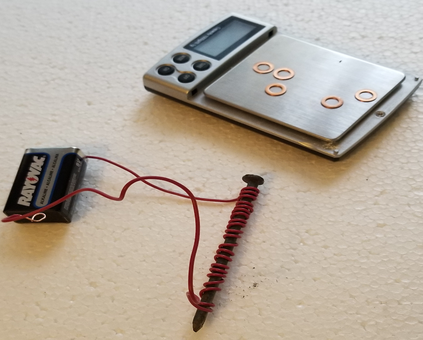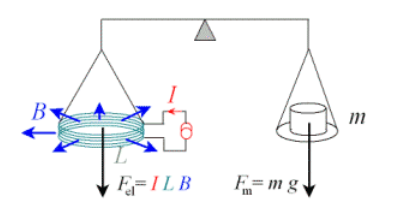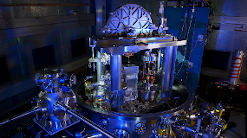Balancing Act
In this activity, you’ll develop a model for equating force and mass, and then look at the actual Kibble balance at NIST and discover how it works.
Teacher Tips!
Many activities have a teacher view and a student view, and teachers can switch between those views by clicking the blue button in the upper-right. Students will not see this option - only teacher accounts see both views. The teacher view will start with overview text, if available, to frame the activity and get you started. This view will also have teacher tips and suggested answers to student questions spread throughout the activity. The teacher text interleaved with student-facing text will be in italics and should appear as a different color on your screen. Teacher tips are designed to help you deliver a learning experience that is best suited for your classroom.
Printing Reminder
Whichever view you see on your screen is what will print. You can print this activity without teacher tips by selecting the student view, or print with teacher tips by switching to teacher view. Simply use the standard print function available for your web browser. No extra steps are required.
Title of Activity:
Balancing Act
Brief Description:
In this activity, students look at a simple model for a relationship between voltage and mass, and then explore the Kibble balance, a tool to use Planck’s constant as a measurement standard.
Target Grade Level:
Grades 8-12
Discipline or Course:
Physical Science
Estimated Time Required:
Two 45-minute sessions
Individual / Partner / Group Work:
Teams of 3-4 for Procedure I, Group for Procedure II
Key Vocabulary:
- Force
- Mass
- Kibble balance
Teacher Prep:
The materials and exact procedures for the electromagnet modeling activity can vary. If your school has electromagnet kits, they can be adapted.
Suggestions for Remote Learning:
With appropriate cautions, the electromagnet project is easy to complete at home.
STUDENT CONTENT BELOW
Using a constant to define a measurement is just one step in achieving accuracy. We must also have the tools that can use the standard and provide the precision that we need. The 2018 move by metrologists to define the kilogram in terms of Planck’s constant opened the door for more direct measurements around the world. Today, the measurement tool of choice for mass is the Kibble balance.
Once called the watt balance, this instrument measures the mass of a test object very precisely by the electric current and voltage needed to produce a compensating force. The force is produced by pulling a coil through a magnetic field at a constant velocity.
First you will build and measure a device that has some of the components of a Kibble balance. You’ll look at how electric current controls and can be used to measure force. It’s not a balance but like the Kibble it has an input (in this case, voltage) and an output (in this case, magnetism which can be used to lift a mass). This model can help you think about the input and output relationship in metrology’s newest and most valuable tool.
Then you’ll explore the Kibble balance at the National Institute of Standards and Technology.
Materials:
Procedure I:
- Electromagnet
- Large iron nail (approximately 3 inches in length)
- Thin coated copper wire
- Variety of dry cells (AAA, AA, C, and 9 volt)
- Electric tape
- Small washers of the same size, at least 10 per group
- Paper clip, as close as possible to mass of washer
- Electronic balance
Procedure II:
- Diagram of Kibble balance
- Web Link - Operating Principles of the NIST-4 Watt Balance
Procedure I: Measuring Mass with Current
- Assemble a circuit and electromagnet.
- Strip the ends of the wire.
- Wrap 20 coils of wire around the nail without overlapping.
- Mass a paper clip and the washers. (Note: They may seem to be the same mass, due to the precision limit of your balance.) The paper clip will represent the first mass in your test “balance.” Open it up slightly to make adding additional masses easier.
- Create your first electromagnet circuit with one 9 volt dry cell.
6. Determine the maximum mass that your electromagnet can lift.
7. Vary the voltage by using a different battery cell. AA and C cells are about 1.5 v. Lantern batteries are 6 v. Determine the maximum mass that can be lifted.
8. Graph the relationship between voltage and force.
Analysis:
- Describe the relationship between voltage and force direct
- The electromagnet converts current to force. How can you calculate the force? Fw (weight) = m (mass) * g (gravity, 9.8 m/s2
- Can you tell if the relationship between voltage and maximum “lift” is linear? No, but if you only have two points, you cannot answer this question.
- If you knew the force, could you predict the mass that could be lifted? If your answer is “yes,” describe how you would do it. yes
Procedure II:
Watch the video here: Web Link - Operating Principles of the NIST-4 Watt Balance
Read the description of the Kibble balance from the Bureau International des Poids et Mesures as you answer the questions. Web Link - The principle of the Kibble balance
Here’s a diagram of the Kibble balance from Bureau International des Poids et Measures, the international group that coordinates organizations like NIST.
A mass and a coil are suspended from a balance. The coil (wire length L) is placed in a magnetic field of flux density B. The gravitational force on the mass m is balanced by an equal and opposite electromagnetic force on the coil by sending a current I through it. The equation that describe this relationship is: m g = I L B
Analysis:
- How is this technology different from your electromagnet model? The force is produced by a magnetic field from a moving coil.
- Describe in your own words how you might use an electrical force to estimate the mass (weight) of an object? Determine the needed force to move the object
- Watch the video on the Kibble (watt) balance. Then describe how it is similar to and different from the simple model you’ve explored. Both the model and the balance have input and output.
- The Kibble balance is based on Planck’s constant and not tied to any artifact; How does this affect metrology? First and foremost, it makes it international. No facility or research is dependent on a mass artifact.
Conclusion:
What have you learned?
What more do you want to know?







